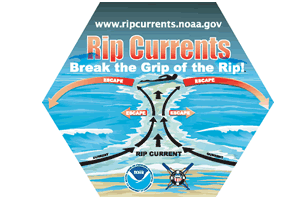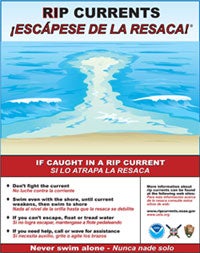Rip Currents
San Diego's diverse coastline includes sandy beaches, underwater reefs, coastal cliffs, rock jetties and piers, all of which create unique hazards for beach patrons. Rip currents are the most threatening of all hazards along San Diego's coast. The United States Lifesaving Association has found that more than 80% of the rescues performed by ocean lifeguards involve saving those caught in rip currents. Additionally, the USLA estimates the number of deaths due to rip currents on our nation's beaches exceeds 100 annually.
What is a rip current?

A rip current is a seaward moving current found at surf beaches and near fixed structures such as jetties and piers. Rip currents are formed when waves breaking in the surf zone push large amounts of water ashore. (The surf zone is the area between breaking waves and the beach) As waves travel into the beach, the water in the surf zone must find a way to travel out to sea. As the water in the surf zone travels seaward, it creates currents. These currents typically form in the deepest areas of the ocean floor and around fixed structures, as these areas provide the least resistance for the water to travel seaward.
What is the difference between a rip current, rip tides and undertows?
Rip currents are sometimes mistakenly called "rip tides" or "undertows." These are misnomers. Rip currents are not directly associated with tides and they do not pull people under.
How do swimmers drown in a rip current?
Rip currents can be very strong and deep and stretch hundreds of yards from shore. Drowning occurs when swimmers become caught in a rip current and can no longer keep themselves afloat or swim back to shore.
What can I do to avoid rip currents?
Ask a lifeguard where to swim, stay within your ability and where you can touch bottom at all times. Always swim near and obey instructions from lifeguards.

Rip Current Poster (PDF)
Survival Tips
Always swim near a lifeguard. If you find yourself caught in a rip current, here are some survival tips:
- Relax and stay calm.
- Swim parallel to the shore. Do not swim against the current.
- Float on your back or tread water if necessary.
- Wave to a lifeguard for help.
If you witness someone in distress, alert the nearest lifeguard. If no lifeguard is available, call 911 and ask for lifeguards. Do not try to swim out to help the victim, as you may become a victim yourself. If possible, try throwing floating objects to the victim.

